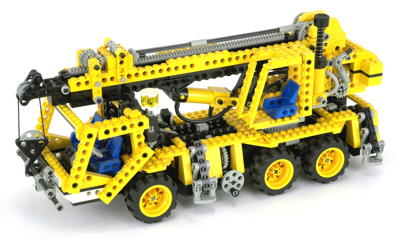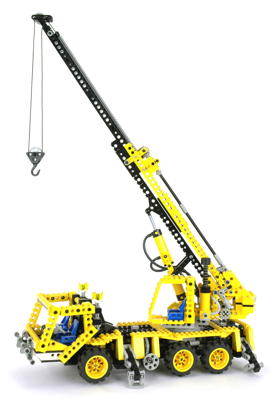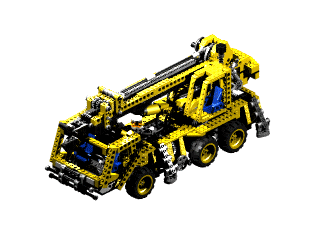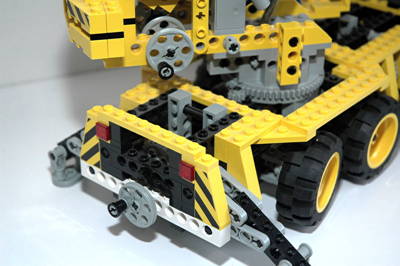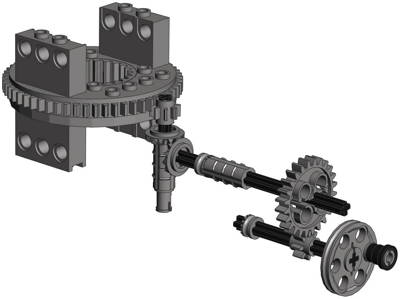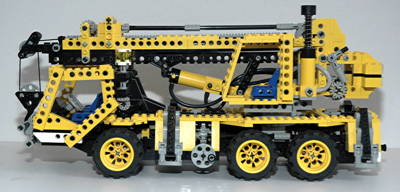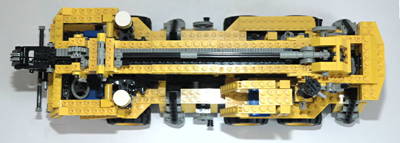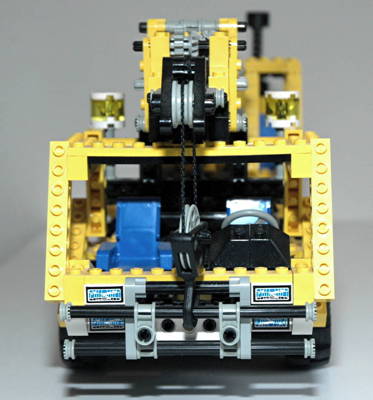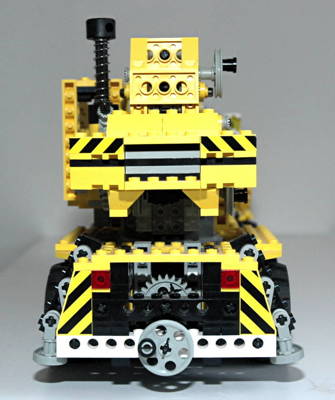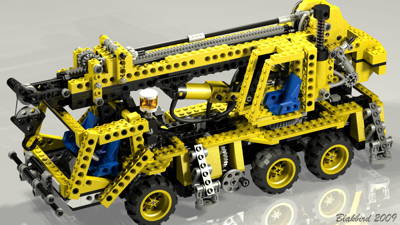Features
|
|
Pneumatics
This model contains a double acting pneumatic system. The components of
this system are connected with rubber tubing.
A single pump provides air pressure. Depression of the piston
produces pressure. The pressure is fed to an inlet of a selector
valve (switch) with two outputs. Selection of the switch in
either direction allows pressure to flow to either chamber of the
actuators.
Finally, there are two pneumatic actuators which have ports at the
head and rod ends
to accept input from the switch. Head end pressure extends the
piston, while rod end pressure retracts it. This model uses a
pair of actuators in series connected via rotors.
|
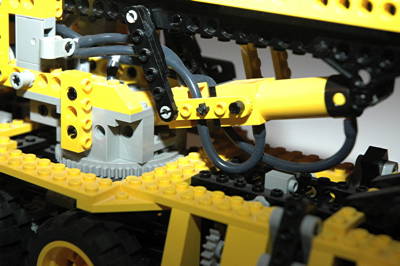 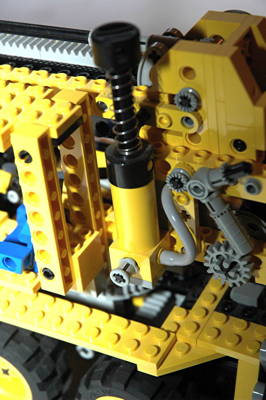
|
|
Steering
The front wheels can be steered using a pair of overhead "hand of god"
controls. The steering
knobs are designed to look like flashing lights. The overhead
control turns the blue axles in the computer image which then turn the
green axles in parallel through a set of bevel gears. The
vertical red axle mates with both bevel gears, linking the two inputs
together and transferring torque downward. The longitudinal axle
shown in tan then drives the front gear rack. Two more
pairs of gears on the brown and white axles reach the rear axle which
turns in the opposite direction. The steering mechanism itself
uses the steering arms
and toothed links.
The two light blue pinion gears move the front and rear axles at
different rates which results in a larger steering lock in front.
This is due to the brown spur gear pair (16:8) which halves the
rotation of the rear steering axle. The center of rotation is
then roughly at the central unsteered axle.
|
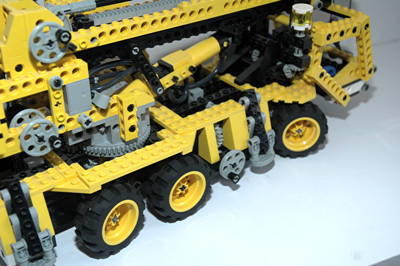
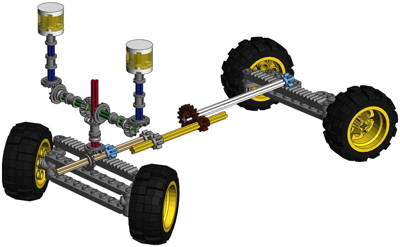
Click for an animation of the
steering in motion. |
|
Luffing Boom
The boom can be pivoted from a position parallel to the ground up to an
angle of about 60 degrees. A pair of pneumatic actuators drive
this motion. They operate in series and extend to luff the
boom.
This is the first time pneumatic actuators were used in series.
Since no special parts existed to accomplish this connection, they are
attached with a pair of rotors and some axles and pins. To keep
the actuators from rolling around their long axis, another pair of
black links on the side clock them to the angle of the boom.
One bit of unexpected design here is that the retract ports of the
cylinders are also plumbed. This has two effects. First, it
slows the descent of the boom since the retract ports cannot just suck
freely from atmosphere. Second, it allows the boom to actually be
pressurized down to hold it down against the chassis. This allows
you to carry around the model using the boom as a convenient handle!
|
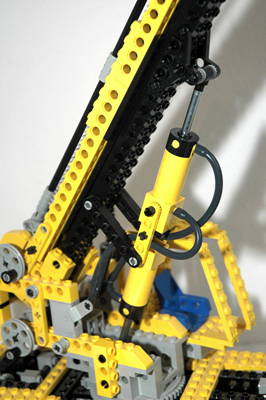
Click for an animation of the
boom
luffing.
|
|
Telescoping Boom
The boom can telescope to approximately 180% of its original length. A
smaller inner boom is constructed of beams topped by gear racks.
It rides upon a support made from another set of black beams
constructed upside down. The resulting smooth surface supports
the telescoping motion.
A crank on the right side drives an axle parallel
to the boom via a worm gear and an 8 tooth pinion. This axle runs
the entire
length of the boom, spliced with another pair of 8 tooth spur
gears. At the upper end of
the boom, the
rotation is turned 90 degrees through a set of 12 tooth bevel
gears. The
cross axle contains a final 16 tooth spur which translates the entire
inner
boom axially as it mates with the rack.
There are stops at either end of the inner boom to prevent it from
extending or retracting too far. The cantilever moment of the
inner boom is significant, so a solid structure braced with vertical
liftarms and rotors is required to keep the whole thing from prying
apart.
As can be seen in the animation, the sheave is effectively raised by
the telescoping of the boom. Since the length of the boom has
increased, less cable is available in the vertical direction.
|
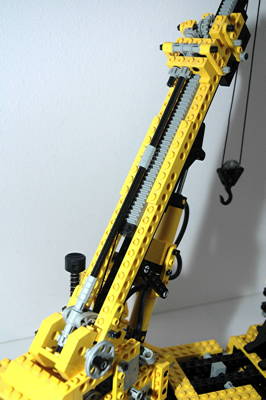
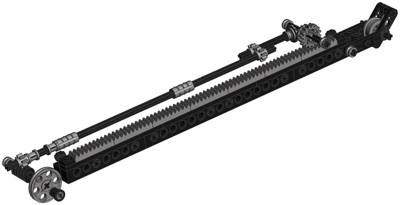
Click for an animation of the
boom
telescopic motion.
|
|
Hoist
A hoist is available which uses LEGO® string to
lift a sheave. A pulley wheel on the right side is used as a
crank
and directly
rotates an axle to which the string is affixed. This axle acts as
a
winding drum and raises and lowers the sheave.
A 16 tooth gear on the left side acts as a ratchet which mates with a
pawl. This supports the tension in the cable.
Even though the metal hook is fairly heavy, sometimes when the cable is
being payed out the weight is not enough to unspool it resulting in a
rat's nest of tangled cable.
|
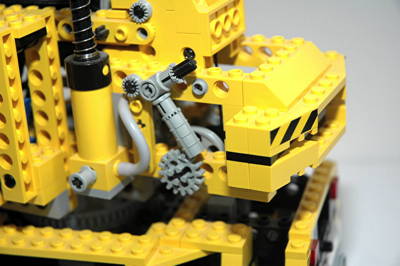
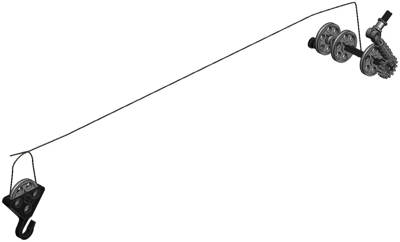
Click for an animation of the hoist
in
motion.
|
|
Slewing
The rotation of the superstructure is accomplished via a crank on the
rear. The crank turns a set of 8 and 24 tooth spur gears, then a
pair of 12 tooth bevels. A final 8 tooth pinion mates with the
outer 56 tooth ring gear on the top of the turntable. This
results in a total reduction of (24:8 x 12:12 x 56:8) = 21:1.
Because no pneumatic hoses or axles pass between the base and the boom,
the
boom can slew 360 degrees without becoming twisted.
|
|
|
Outriggers
There are two pairs of outriggers behind the front and rear wheels
which are
constructed using 1x4 liftarms and standard beams. The pads are
made from cams.
A crank on each side independently drives the front and rear outrigger
on that side. The crank drives a worm gear which then drives a 24
tooth spur gear resulting in 24:1 reduction. An axle on the 24
tooth gear runs the entire length of the chassis and directly drives
the rotation of the driving links of the outriggers. A secondary
linkage below the driving links makes this a 4-bar linkage.
Because the arms are 3 studs apart at one end and only 2 studs apart at
the other, the outrigger arm rotates as it deploys.
Due to a careful selection of geometry, the outriggers are
self-locking. When fully deployed, weight on the foot tends to
rotate the two sets of liftarms together, locking the assembly, rather
than trying to backdrive them. It is this geometry, rather than
the worm gear, that prevents the outriggers from collapsing under
weight.
The outriggers provide a wide base for stability and are
slightly taller than the tires so that all 6 tires are lifted off of
the
ground.
|
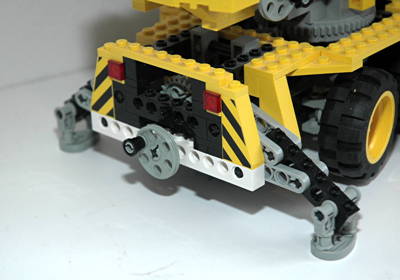
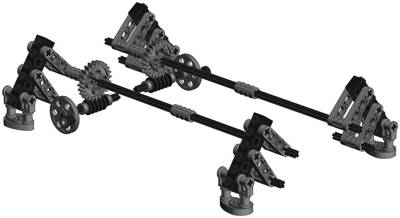
Click for an animation of the
outrigger
in motion.
|
|
Wheels and Tires
This set uses six of the smaller size 20x30 balloon tires and wheels. |
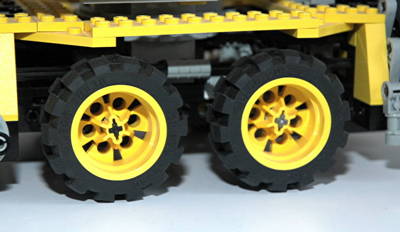
|

